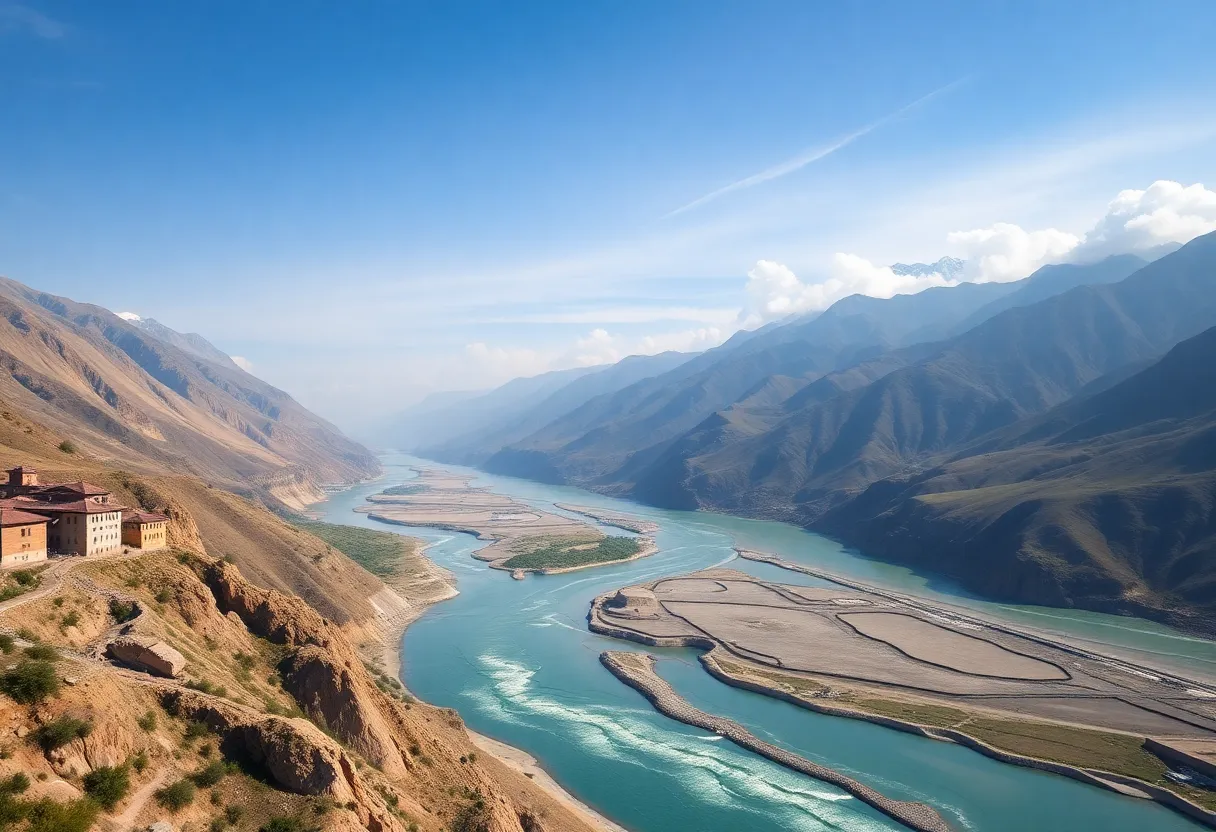News Summary
China has commenced construction on the largest hydropower project on the Yarlung Zangbo River. This ambitious initiative aims to generate up to 300 billion kilowatt-hours annually and involves significant investment and the establishment of key hydropower stations. The project has raised concerns among neighboring countries over potential ecological and social impacts, particularly in India. While it’s designed to enhance China’s renewable energy output, it also highlights the geopolitical complexities surrounding water resources in the region.
Construction Begins on World’s Largest Hydropower Dam in Tibet
Chengdu, China — China has officially started construction on a massive hydropower project on the Yarlung Zangbo River, also known as the Brahmaputra in India and the Jamuna in Bangladesh. This project is set to become the world’s largest source of hydroelectric energy, with the capacity to generate up to 300 billion kilowatt-hours annually.
Project Overview and Scope
The construction site is located in Tibet, just 30 kilometers from China’s border with India. The project involves the development of five hydropower stations, including the prominent Yagen Hydropower Station, which alone is expected to displace around 2,000 residents. The entire scheme aims to harness the significant hydropower potential of the Yarlung Zangbo, a river renowned for its dramatic waterfalls and high elevation drops.
Key Figures and Investment
The initiative is supported by a substantial investment estimated at approximately 1.2 trillion yuan, or around 167 billion U.S. dollars. Once completed, the dam might produce three times the energy generated by the Three Gorges Dam, currently the world’s largest hydroelectric power station. The project reflects China’s strategic approach to expanding renewable energy sources while supporting regional economic development and Tibet’s infrastructure.
Official Launch and Government Involvement
The commencement of construction was attended by Premier Li Qiang, signaling its national importance. The project had been under planning for several years, with formal approval granted in December of the previous year. Chinese authorities emphasize that the dam will primarily supply electricity beyond Tibet to other Chinese regions, aiming to meet increasing demand and support the country’s carbon neutrality objectives.
Regional and International Reactions
The Yarlung Zangbo River, a vital water source for approximately 1.3 billion people across ten countries, has sparked concerns among downstream nations, particularly India. In January, India raised questions about potential impacts of the dam on downstream communities and emphasized the need for China to ensure that upstream activities do not adversely affect other countries. China’s Foreign Ministry responded by stating that the project would not cause negative downstream effects and assured ongoing communication with neighboring nations.
Ecological and Social Considerations
The Tibetan Plateau, where the dam is being constructed, functions as a critical water reservoir feeding major Asian rivers. Historically, the construction of dams in Tibet, especially since China’s annexation of the region in 1950, has raised ecological concerns. Critics highlight the risk of irreversible damage to ecosystems on the Tibetan Plateau. Environmental groups have expressed fears about habitat disruption, changes in river flow, and threats to downstream agriculture and fisheries.
Environmental and Cultural Significance
The Yarlung Zangbo is known for its remarkable natural features, including a steep drop of approximately 6,561 feet over a short distance, contributing to its high hydropower potential. The river is also considered sacred by Tibetans, emphasizing the cultural importance of the site. The dam’s construction has prompted discussion about balancing ecological preservation with energy needs.
Impacts and Future Outlook
In comparison to the Three Gorges Dam, which displaced about 1.4 million residents, the new project in Tibet is expected to involve fewer relocations but still impacts local communities. The project is designed to stimulate related industries in Tibet, generate jobs, and promote renewable energy deployment across China. Construction is already underway on the upper reaches of the river, indicating progressing work toward operational status in the coming years.
Environmental and Regional Challenges
The project’s proximity to territorial dispute zones adds a geopolitical dimension, especially considering its closeness to India. Experts warn that large-scale hydro projects on the Yarlung Zangbo could influence regional water security, with the potential to alter flow patterns and impact multiple downstream nations. Ongoing international dialogue and environmental assessments are expected to accompany the project’s development to address these concerns.
As China advances with the construction of the world’s largest hydropower station on the Yarlung Zangbo River, the project exemplifies the country’s dual focus on energy security and ecological sustainability, while also navigating complex regional and environmental challenges.
Deeper Dive: News & Info About This Topic
HERE Resources
Additional Resources
- Al Jazeera
- Wikipedia: Yarlung Zangbo River
- NBC News
- Google Search: China hydropower dam Tibet
- Bloomberg
- Google Scholar: China hydropower dam Tibet
- Reuters
- Encyclopedia Britannica: Hydropower
Author: STAFF HERE WASHINGTON DC
The WASHINGTON DC STAFF WRITER represents the experienced team at HEREWashingtonDC.com, your go-to source for actionable local news and information in Washington, DC, and beyond. Specializing in "news you can use," we cover essential topics like product reviews for personal and business needs, local business directories, politics, real estate trends, neighborhood insights, and regional news affecting the area—with deep expertise drawn from years of dedicated reporting and strong community input, including local press releases and business updates. We deliver top reporting on high-value events such as the National Cherry Blossom Festival, Kennedy Center Honors, and the Washington Auto Show. Our coverage extends to key organizations like the Greater Washington Board of Trade and Destination DC, plus leading businesses in government contracting and technology that power the local economy such as Lockheed Martin and Amazon. As part of the broader HERE network, we provide comprehensive, credible insights into the dynamic landscape of the Washington metropolitan area.





